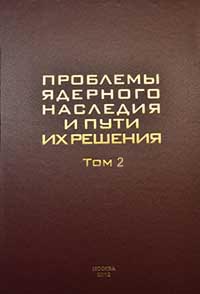| Русский / English |
|

|
NUCLEAR SAFETY INSTITUTE OF THE
RUSSIAN ACADEMY OF SCIENCES
|
THE PROBLEMS OF THE NUCLEAR LEGACY AND THE WAYS OF THEIR SOLUTIONS. VOLUME 2. DEVELOPMENT OF RADIOACTIVE WASTE MANAGEMENT SYSTEM IN RUSSIA
 Publish year: 2013 Pages: 392 | PUBLISHER: Открытое акционерное общество «ЭНЕРГОПРОМАНАЛИТИКА» PUBLISHER: JSC ENERGOPROMANALITIKA Edited by L.A. Bolshov, N.P. Laverov, I.I. Linge The second volume of the three-volume monograph "Problems of the nuclear legacy and the ways of their solution" covers a detailed analisys of the problems of radioactive waste management. The reader will find here a significant factual material on comparison of the risks associated with radioactive waste and conventional production and consumption wastes and the best practices in the RW management. Bibliographic reference: The problems of the nuclear legacy and the ways of their solutions. Volume 2. Development of radioactive waste management system in Russia. — Edited by L.A. Bolshov, N.P. Laverov, I.I. Linge. — Moscow: 2013 — 392 p. — V.2. |
Authors: Vasilyev V.A. (Chapter 4), Zakharchev A.A. (Section 4.1, 4.5, 4.6), Grigorjev A.V. (Section 4.5), Komarov E.A. (Section 4.1) - State Corporation “Rosatom”; Rybalchenko A.I. (Section 7.3) - JSC VNIPIpromtechnologies; Polyakov Yu.D. (Chapters 3-5) - FSUE "National Operator for Radioactive Waste Management"; Abalkina I.L. (Section 1.1), Antipov S.V. (Section 4.4), Bolshov L.A. (Chapter 3, 7), Dorogov V.I. (Chapter 2), Ilyushkin A.I. (Section 4.1), Kapyrin I.V. (Section 7.2), Kovalchuk V.D. (Chapter 3), Linge I.I. (Chap. 1-7, Appendix 1), Obodinsky A.N. (Chapter 4), Panchenko S.V. (Appendix 1), Savelyeva-Trofimova EA (Section 7.3), Sarkisov A.A. (Chapter 4), Utkin S.S. (Section 4.2, Chapter 7, Appendix 1) - IBRAE RAN; Supataeva O.A. (Chapter 2) - Institute of State and Law of the Russian Academy of Sciences, Khamaza A.A. (Sections 2.2, 3.1 and 4.7), Sharafutdinov R.B. STC NRS Rostechnadzor (Section 3.1-3.3 and 5.4, Appendix 1).
The second volume of the three-volume monograph "Problems of the nuclear legacy and the ways of their solution" is brought to reader’s attention. The first volume deals with the formation of problems of nuclear legacy in the defense and peace areas, assesses the scale of these problems, outlines the ways for their phased solution and Вниманию читателя предлагается mechanisms that prevent their reproduction in the future.
The second volume covers a detailed analisys of the problems of radioactive waste management. The reader will find here a significant factual material on comparison of the risks associated with radioactive waste and conventional production and consumption wastes and the best practices in the RW management.
The materials of the monograph provide an opportunity to understand the process of search for solutions in strategic areas of development in this fild and correlate with the real changes that have occurred during the last decade. These changes can be characterized as significant progress. Examples of this progress are related to the implementation of the federal target program "Ensuring Nuclear and Radiation Safety for 2008 and for the Period to 2015", and with cooperation within the framework of the Global Partnership, and with the implementation of programs of nuclear industry organizations. The second component of progress is the creation of the Unified State System for Radioactive Waste Management regulated by the relevant law.
The book is addressed to scientists and experts of nuclear science and industry, as well as a wide range of readers interested in the issues of safe solution of nuclear legacy problems.
 |
IBRAE RAN © 2013-2025 | Site map | Feedback |